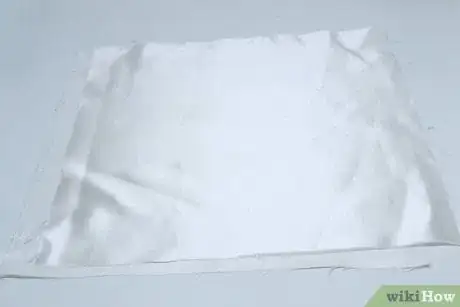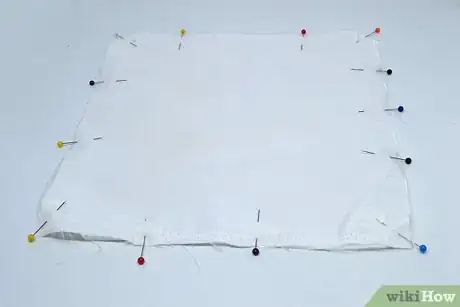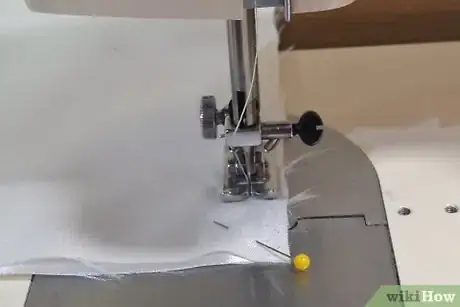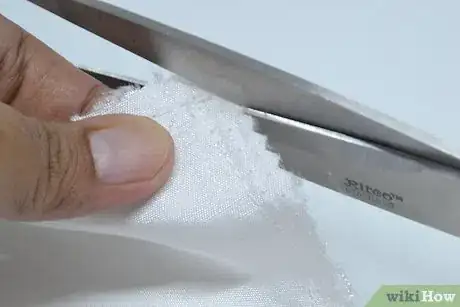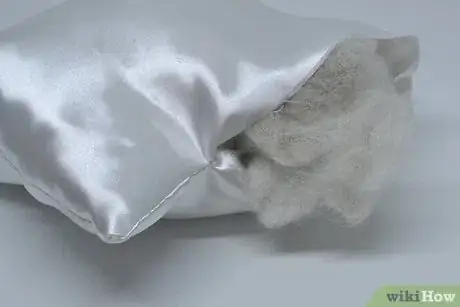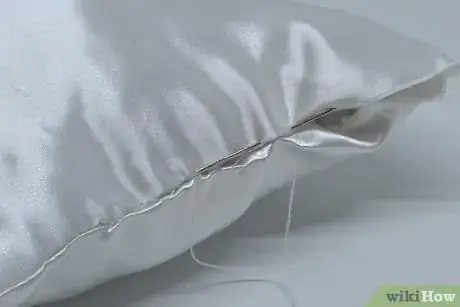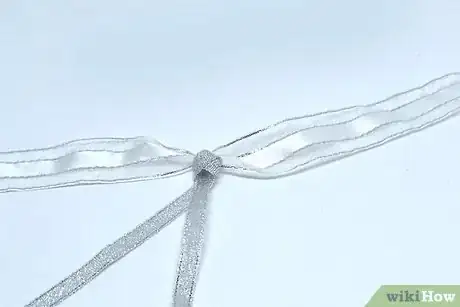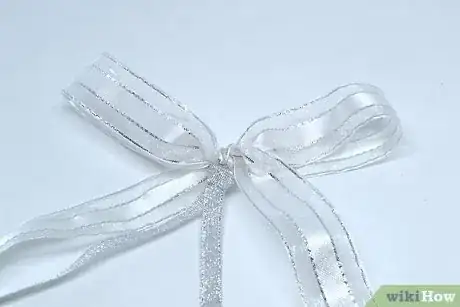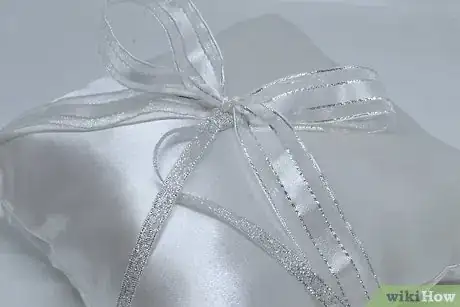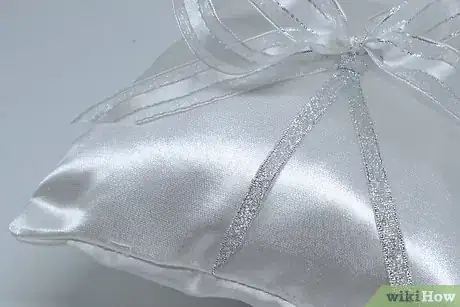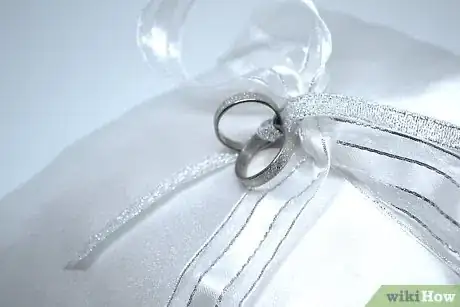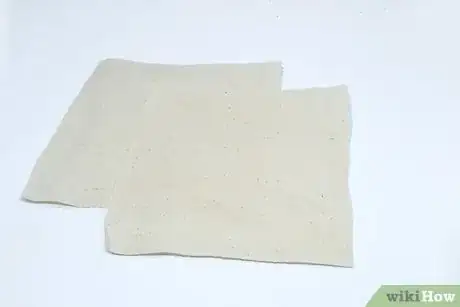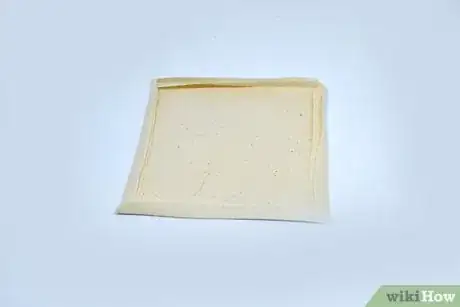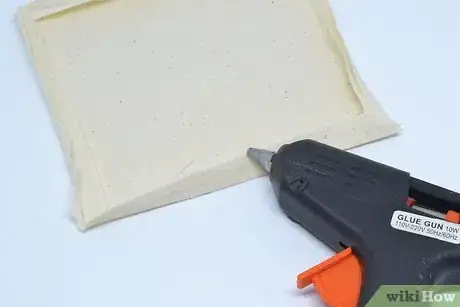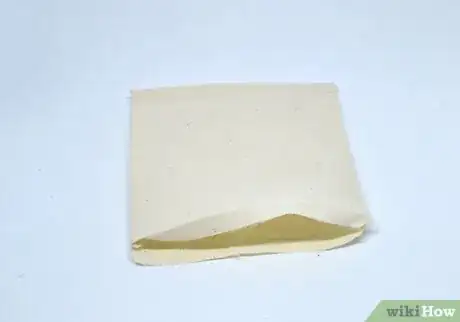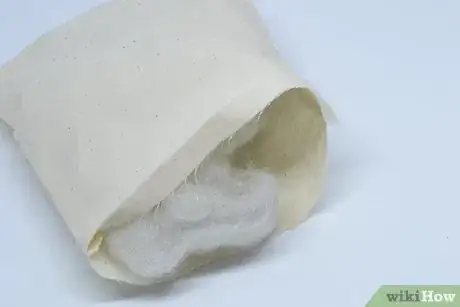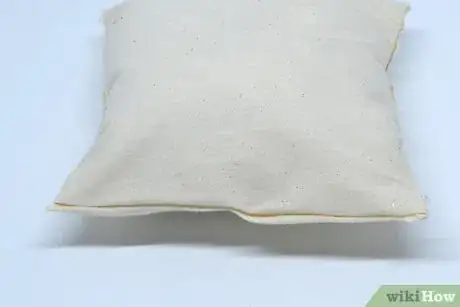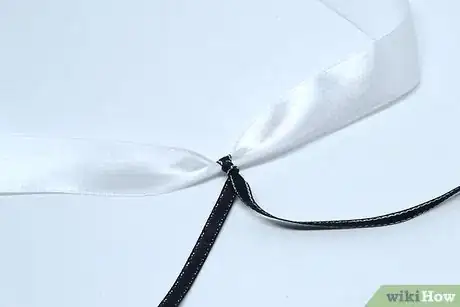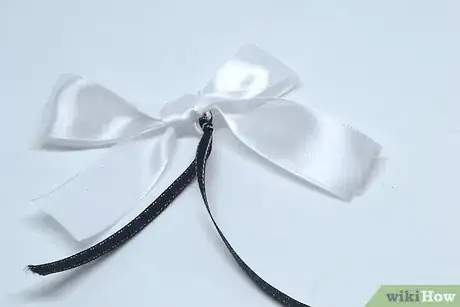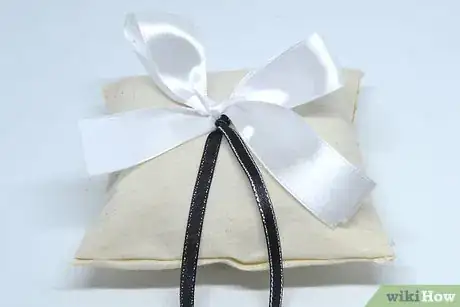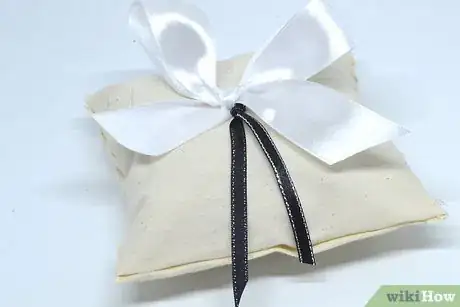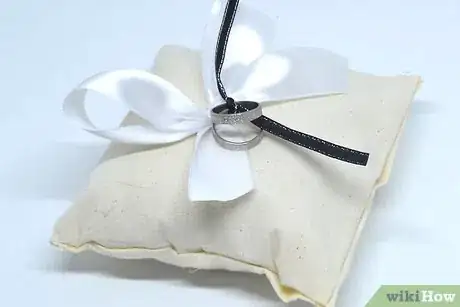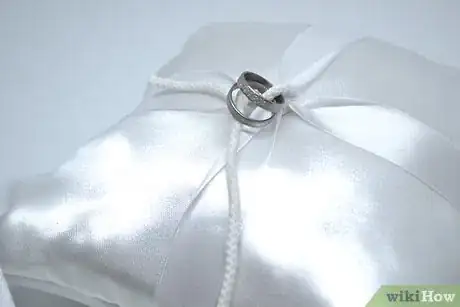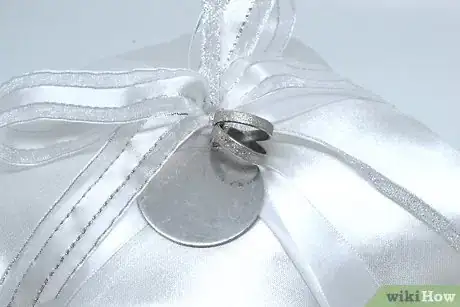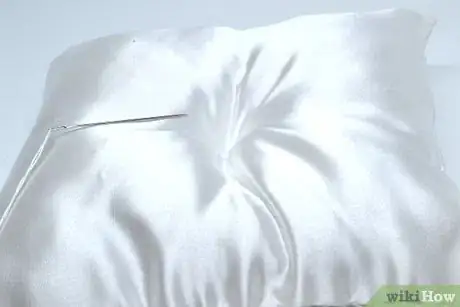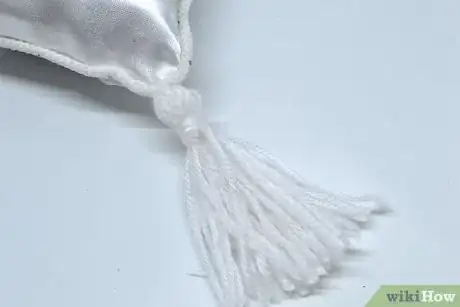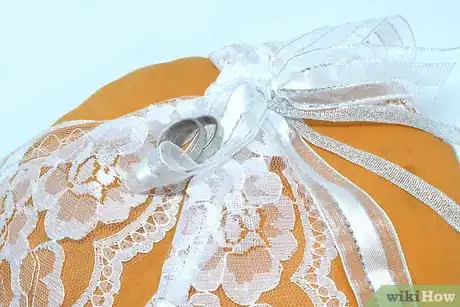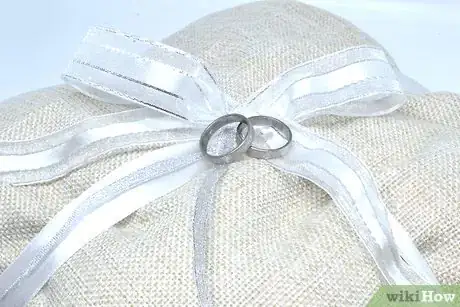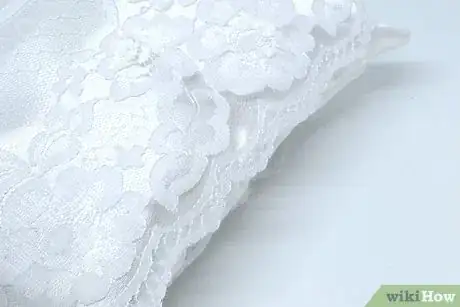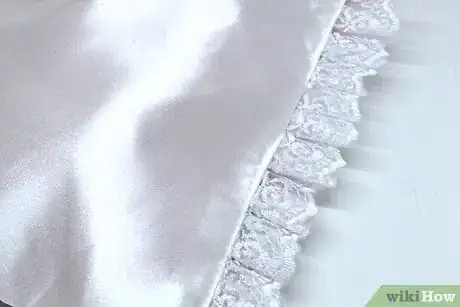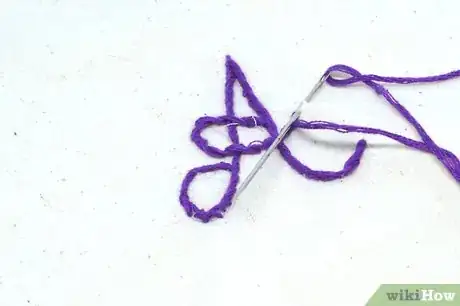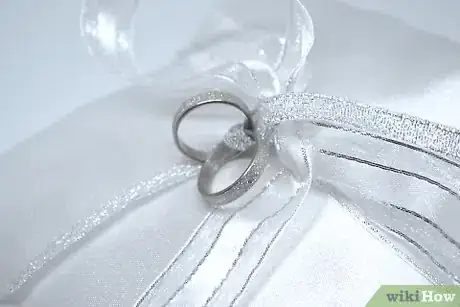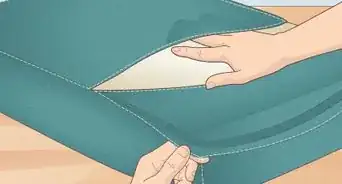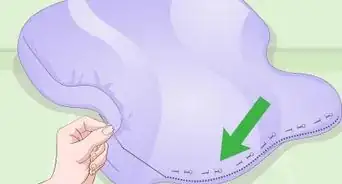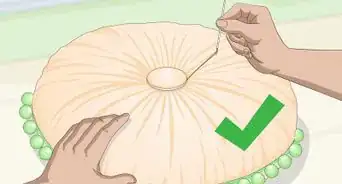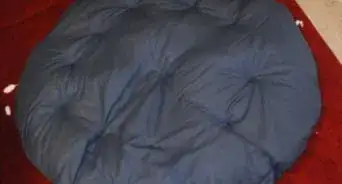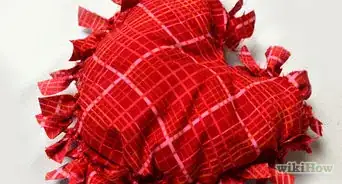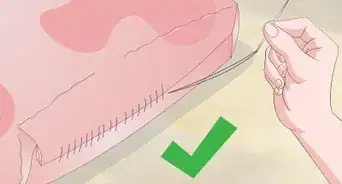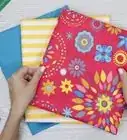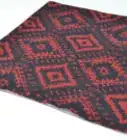This article was co-authored by wikiHow Staff. Our trained team of editors and researchers validate articles for accuracy and comprehensiveness. wikiHow's Content Management Team carefully monitors the work from our editorial staff to ensure that each article is backed by trusted research and meets our high quality standards.
This article has been viewed 57,144 times.
Learn more...
Ring pillows are a popular wedding tradition. The wedding rings rest on the pillow as the ring bearer carries them to the altar. While you can always buy a simple pillow from the store, it may not match the overall theme of your wedding. It is easy to make your own pillow and a great way to bring a unique touch to your special day.
Steps
Sewing a Simple Pillow
-
1Select your fabric. Cut 2 x 10 in (25 cm) squares of fabric. Choose a fabric that matches your wedding colors. It can be anything you like: satin, cotton, burlap, etc. If the fabric has a print, make sure that it goes with your wedding theme.[1]
- You can make the pillow a different size but make sure to add a 1⁄2 inch (1.3 cm) seam to the length and width.
-
2Stack the squares with the right sides together. Set the first square with the right side up. Place the second square on top, with the right side facing down. Secure the edges with pins.[2]Advertisement
-
3Sew three of the edges with a 1⁄4 in (0.64 cm) seam allowance. This is fastest using a sewing machine, but it can be sewn by hand too. Use a straight stitch and a matching thread color.[3]
- If you don't know how to sew, secure the edges with hot glue or fabric glue. Allow the glue to dry before continuing.[4]
-
4Trim the corners. While not absolutely necessary, this will reduce bulk and help your pillow look nicer. Cut as close to the stitching as possible without cutting through the thread. Be sure to clip the corners along the edge you left open. This will make it easier to sew it shut later.
-
5Turn the pillow right side out. Flip the corners into the pillow, then pull them out through the opening. Use something blunt and pointy, like a knitting needle or pencil to push the corners out further.
-
6Stuff the pillow. Polyester stuffing will work the best. You can use other types of filling, such as foam or a blank ring pillow.
-
7Close the open seam. Push the stuffing into the pillow so that it does not stick out. Fold the raw edges of the opening in by 1⁄4 inch (0.64 cm), then secure them with sewing pins. Hand sew the opening shut with a ladder stitch, then remove the pins.[5]
- If you don't want to sew, hot glue the opening. Work on 1 inch (2.5 cm) at a time. Press and hold the section until it sets before doing the next section.
- You can use fabric glue on the opening. Work on 1 inch (2.5 cm) at a time. Secure each section with a clothespin until the glue dries.
-
8Attach a string to a ribbon with a slipknot. Choose a piece of ribbon and string that match your pillow. Fold the string in half to make a loop that is positioned behind the ribbon. Pull the ends of the string to make a knot around the ribbon, then tug on them to tighten the knot. Slide the knot across the ribbon until it is centered.
- For a fancier pillow, use a 1⁄16 or 1⁄8 in (1.6 or 3.2 mm) ribbon instead of string.
- The ribbon will make the decorative bow. The string will allow you to tie the rings to the pillow.
-
9Form the ribbon into a bow. Fold the left and right ends of the ribbon into loops. Cross the left loop over the right loop, then thread it through the gap that you made. Tug on the loops to tighten the bow.
- Leave the strings out of the bow.
-
10Secure the bow. Position the bow in the middle of the pillow. You can sew the bow on with matching thread or hot glue the bow instead. Make sure that the strings and the tails of the bow are hanging below the loop.
- If you want to create a tufted pillow, sew a few stitches through the middle of the pillow first. Click here to learn more.
-
11Trim and singe the ribbon and strings. Cut the ribbon and strings down to the length you want. If the material is fraying, singe the ends with a flame.
-
12Tie the rings to the strings. Thread both of the rings onto one of the strings. Tie both strings into a knot or a bow.
Making a No-Sew Pillow
-
1Cut 2 x 10 in (25 cm) squares of fabric. This method will give a rustic look, so a heavy fabric like burlap, linen, or canvas will work best. Choose a color that matches your wedding theme. If the fabric has a print on it, make sure that the print is suitable.
- If you want the pillow a different size, add 1 inch (2.5 cm) to the length and width.
-
2Clip the corners by 1⁄4 inch (0.64 cm). This will reduce bulk when you fold the fabric. It will also help conceal the raw edges.[6]
-
3Set the seams. Turn the fabric so that the wrong side is facing you. Fold the four edges down by 1⁄4 inch (0.64 cm) towards the wrong side. Press the fabric with an iron, if needed. Repeat this step for the second piece of fabric.[7]
- Burlap holds folds and creases easily, so you do not need to press it with an iron.
-
4Glue the hems down. Unfold one of the edges. Draw a thin line of hot glue or fabric glue along the edge, then press it back down. Do this for all of the 1⁄4 in (0.64 cm) hems on both fabric squares.[8]
- Hot glue sets within minutes, but fabric glue needs about 10 to 15 minutes to dry.
- Trim any frayed bits of fabric sticking out.
-
5Glue the squares. Set the first square down with the wrong side up. Place your second square on top, with the right side up. Glue three of the edges together using hot glue or fabric glue. Leave the fourth edge open and allow the glue to dry.[9]
- Make sure that the entire 1⁄4 in (0.64 cm) width of each hem is coated with glue. This will give you a flanged seam.
-
6Stuff the pillow to your desired fullness. Polyester stuffing will work the best, but you can also use a piece of foam or a mini pillow insert. You can also use a plain ring pillow, as long as it is the same size.[10]
-
7Glue the final seam. Use your fingers to push the stuffing into the pillow so that it does not get caught in the glue. Working 1 inch (2.5 cm) at a time, glue the final seam down.[11]
- If you are working with hot glue, press and hold each section until it dries before moving onto the next.
- If you are working with fabric glue, secure the section with a clothespin, before moving onto the next section. Remove the pins once the glue dries.
-
8Secure a string to a ribbon with a slip knot. Choose a coordinating ribbon and cord that match your pillow. Fold the string in half, then place it behind the ribbon to make a loop. Pull the ends of the string over the ribbon and through the loop. Pull on the ends of the string to tighten the knot.
- Center the string. If it isn't, slide it across the ribbon until it is.
- The ribbon will form the decorative bow. The string will secure the rings to the pillow.
-
9Tie the ribbon into a bow. Take the left and right sides of the ribbon, and fold them into loops. Cross the left loop over the right loop, then thread it through the hole you made. Pull on the loops to tighten the bow.
- Do not include the string in the bow.
- Tug on the ribbon loops and tails to adjust the bow.
-
10Glue the bow. Place a large drop of hot glue or fabric glue in the middle of the pillow. Adjust the bow so that the tails and strings hang below the loops. Press the bow into the glue and let it set.[12]
-
11Trim and singe the ribbon and string. If the ribbon tails or the strings are too long, trim them to the length you want. If the material is fraying, singe them with a flame.[13]
-
12Tie the rings to the pillow. Thread both rings onto the left string and tie both strings together into a simple knot. You can also tie the strings into a bow for a fancier look.
Decorating a Ring Pillow
-
1Tie a ribbon around a pillow. Cut a length of ribbon at least 4 times the width of the pillow. Center the pillow over the ribbon. Wrap the ribbon ends around the sides of the pillow. Tie the ribbon into a knot in the front of the pillow. Add the rings, then tie the ribbon into a bow.[14]
-
2Add a symbolic charm to the bow. Choose a charm that is meaningful, such as a horseshoe for good luck, or a heart for love. Sew it to the pillow under the bow, or slide it onto the ribbon before tying it into a bow.[15]
-
3Embellish a pillow with ribbon rosettes. Purchase miniature ribbon roses or rosettes. If they are attached to wire stems, trim the stems down to just beneath the bud. Hot glue the rosettes to your pillow as desired. Adding them around the bow would be ideal.[16]
-
4Create a tufted look. Sew a few stitches through the center of the pillow. Thread a needle and push it through the front of the pillow and out the back. Move the needle over 1⁄8 to 1⁄4 inch (0.32 to 0.64 cm), then push it from the back and out the front. Do this one more time to create an X. Knot and cut the thread. Cover the X in the front of the pillow with a ribbon bow.
-
5Add a corded trim and tassels for a lavish touch. Hot glue thin cording to the seams of your pillow. Make some tassels using matching embroidery thread. Sew them to the corners of the pillow.
- Silver and gold colors make for great accents, but other colors can also be used.
- If you prefer not to use hot glue, try fabric glue. You can also sew the cord using a whipstitch.
Creating Fancier Pillows
-
1Make a different shape for a unique touch. This may not work well for no-sew pillows, but it is a great option for sewn pillows. Cut two identical shapes out of the desired fabric and sew them together. Leave a 3 to 4 in (7.6 to 10.2 cm) gap. Turn the pillow, stuff it, then sew the gap shut.
- Try a circle, heart, or rectangle shape.
- Remember to clip corners and cut V-shaped notches into curved edges.
-
2Experiment with different fabric choices. Instead of using satin for the pillow, try a unique fabric, such as burlap. You can also use a fancy embroidered fabric for the front with a plain fabric for the back.
- Look in the prom and formal section of the fabric store. You'll find all sorts of fancy fabrics including ones with rosettes!
-
3Add a lace overlay before assembling the pillow. Cut a third square of lace fabric. Sew it to the right side of the first fabric square with a 1⁄4 in (0.64 cm) seam allowance. Assemble the pillow using the Simple Pillow method.
- Other fabric options include chiffon and organza.
- For a unique touch, use a strip of lace ribbon. Cut it to the width of the square, and sew the short ends down.[17]
- You can do this with the glued pillow method. Simply glue the edges of the lace and fabric together.
-
4Add ruffled trims. Before you assemble the pillow, pin the trim to the right side of one square fabric piece. Align the edges of the trim with the edges of the fabric. Pin then sew it together using a 1⁄8 in (0.32 cm) seam allowance. Remove the pins, then sew the pillow as directed in the sewing method.
- Ruffled lace trims look more romantic or you can use a fabric lace.
-
5Embroider the fabric. Before assembling, Embroider the front piece of fabric by hand or with an embroidery machine. Assemble the pillow using one of the first two methods.
- The embroidery can be as simple or as detailed as you want it to be.
- Simple embroidery works best for rustic pillows, such as burlap, linen, or canvas.
- Detailed embroidery works best for fancier fabrics, such as silk, satin, or velvet.
-
6Finished.
Community Q&A
-
QuestionWhat materials do I need to make a ring pillow?
 ToastedMarmaladeGracieCommunity AnswerYou could use flannel, fleece, or even felt. You will need a sewing machine (or needle and thread) and some scissors.
ToastedMarmaladeGracieCommunity AnswerYou could use flannel, fleece, or even felt. You will need a sewing machine (or needle and thread) and some scissors. -
QuestionWhat size do I cut the fabric?
 T. ChinsenTop AnswererA standard ring pillow is smaller than the 10" size used in the article. Most paper patterns use an 8" or 9" square size including a 1/4" seam allowance. Most ring bearers are small children. It makes sense for a better photo if the pillow is in proportion to the person holding it. The finished pillow is about 7" or 8" in size.
T. ChinsenTop AnswererA standard ring pillow is smaller than the 10" size used in the article. Most paper patterns use an 8" or 9" square size including a 1/4" seam allowance. Most ring bearers are small children. It makes sense for a better photo if the pillow is in proportion to the person holding it. The finished pillow is about 7" or 8" in size.
Warnings
- Use caution with any hot glue guns. A low-temp hot glue gun instead of a high-temp one will be less likely to burn or give you blisters.⧼thumbs_response⧽
Things You'll Need
Sewing a Simple Pillow
- Fabric
- Fabric scissors
- Sewing pins
- Sewing machine
- Needle
- Thread
- Ribbon
- String
- Polyester stuffing
- Hot glue or fabric glue (optional)
Making a No-Sew Pillow
- Fabric
- Fabric scissors
- Sewing pins
- Iron
- Ribbon
- String
- Polyester stuffing
- Hot glue or fabric glue
Decorating a Ring Pillow
- Ring pillow
- Hot glue or fabric glue
- Embellishments or trim
Creating Fancier Pillows
- Ring pillow making supplies
- Fancy fabric
- Fancy trim
References
- ↑ https://sweetcsdesigns.com/make-a-burlap-ring-pillow-for-less-than-10-in-10-minutes/
- ↑ https://sweetcsdesigns.com/make-a-burlap-ring-pillow-for-less-than-10-in-10-minutes/
- ↑ https://sweetcsdesigns.com/make-a-burlap-ring-pillow-for-less-than-10-in-10-minutes/
- ↑ https://www.weddingbee.com/diy-projects/diy-your-own-adorable-wedding-ring-pillow/
- ↑ https://sweetcsdesigns.com/make-a-burlap-ring-pillow-for-less-than-10-in-10-minutes/
- ↑ http://somethingturquoise.com/2014/07/11/diy-burlap-ring-bearer-pillows/
- ↑ http://somethingturquoise.com/2014/07/11/diy-burlap-ring-bearer-pillows/
- ↑ http://somethingturquoise.com/2014/07/11/diy-burlap-ring-bearer-pillows/
- ↑ http://somethingturquoise.com/2014/07/11/diy-burlap-ring-bearer-pillows/
- ↑ http://somethingturquoise.com/2014/07/11/diy-burlap-ring-bearer-pillows/
- ↑ http://somethingturquoise.com/2014/07/11/diy-burlap-ring-bearer-pillows/
- ↑ http://somethingturquoise.com/2014/07/11/diy-burlap-ring-bearer-pillows/
- ↑ http://somethingturquoise.com/2014/07/11/diy-burlap-ring-bearer-pillows/
- ↑ https://sweetcsdesigns.com/make-a-burlap-ring-pillow-for-less-than-10-in-10-minutes/
- ↑ https://sweetcsdesigns.com/make-a-burlap-ring-pillow-for-less-than-10-in-10-minutes/
- ↑ https://sweetcsdesigns.com/make-a-burlap-ring-pillow-for-less-than-10-in-10-minutes/
- ↑ http://www.morelikehome.net/2012/07/burlap-lace-ringbearer-pillow-tutorial.html
